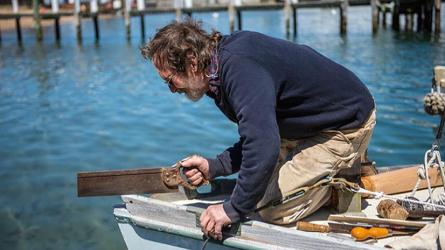The Last of the Vikings
An immersion in the folk wisdom of a thousand years
An immersion in the folk wisdom of a thousand years
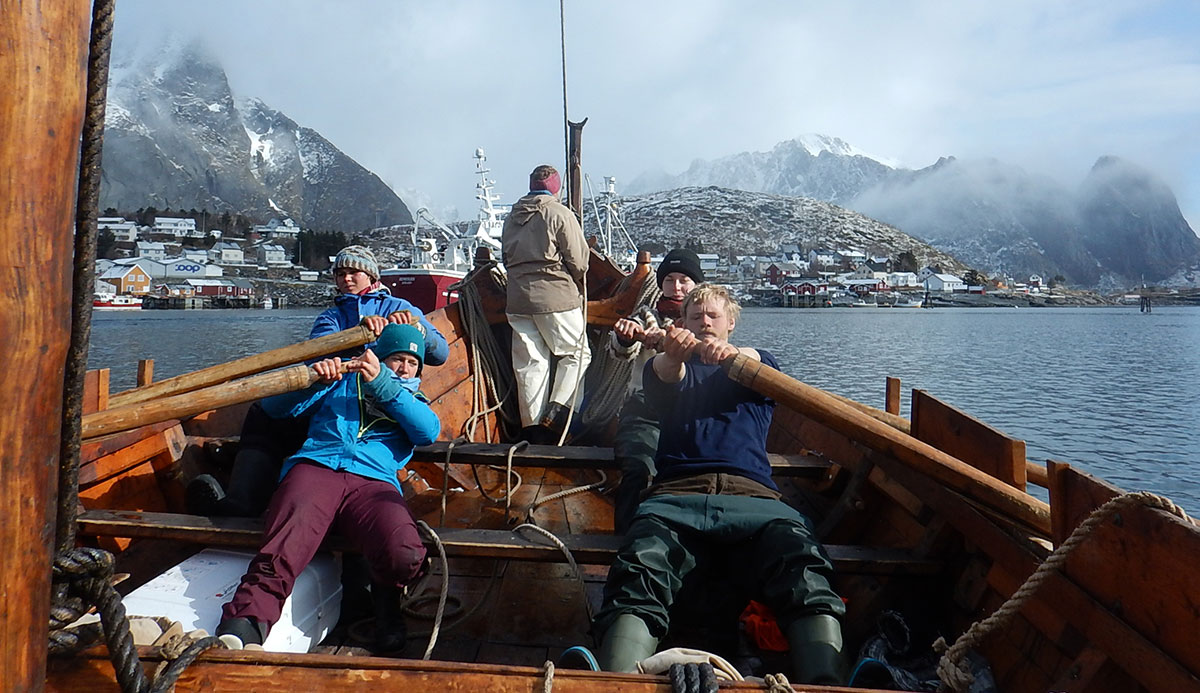

COURTESY OF FOSEN FOLKHØGSKOLE
Aboard the 42′ Norwegian fembøring SKÅRUNGEN, crew member Lukas Røllings entertains his shipmates with a Norwegian romance novel while en route to the westernmost of the Lofoten Islands, Røst. One hundred years ago, thousands of such vessels fished this region for cod.
The night before our 70-mile open-water crossing from the Norwegian island of Sørværet to the Lofoten Islands, Gunvor Storaas, the 27-year-old skipper, checked the wind forecast on her phone. The next day, it was going to blow 40 knots from the south. The vessel in which we were sailing, a 42′ fembøring called SKÅRUNGEN, is of a type that represents the last evolution of a thousand-year Viking boat lineage. In the mid-1800s, thousands of these boats were used to fish cod in the Lofotens during the winter months before returning, their crews perhaps richer, to the Trondheim region in the spring.

ARISTA HOLDEN
The Lofoten Wall is a welcome sight after sailing triple-reefed for more than 60 miles across the Westfjørd. SKÅRUNGEN’s crew is composed of students from the Fosen Folkhøgskole in Rissa, Norway.
We had departed Rissa, Norway, in Trondheim Fjord several days earlier, and made our way up the west coast as part of an 800-mile round-trip voyage that would last three weeks and carry us to Norway’s fabled Lofoten chain. The crew was composed of eight students from the Fosen Folkhøgskole (folk school) in Rissa, which offers yearlong courses in the traditional folk arts including boatbuilding, sailing, farming, self-sufficiency, and crafts. The sailing students sail throughout the winter in a fleet of Fosen-built Åfjørd’s boats including four-oared færings and larger fembørings.

COURTESY OF FOSEN FOLKHØGSKOLE
The line hooked to the middle of the sail’s foot is the priar; it runs through a block at the base of the mast to a belaying pin and is used to adjust the sail’s draft according to the point of sail.
Gunvor and the 20-year-old first mate, Gea Prytz, are Fosen alumnae. I had corresponded with Lena Börjesson, a teacher at the school, about her 30-year study and practice of traditional Viking-age navigation techniques, and when the opportunity came up for me to join this expedition last year, I leapt at it. With each day of sailing, I became more convinced of the seaworthiness of the fembøring.
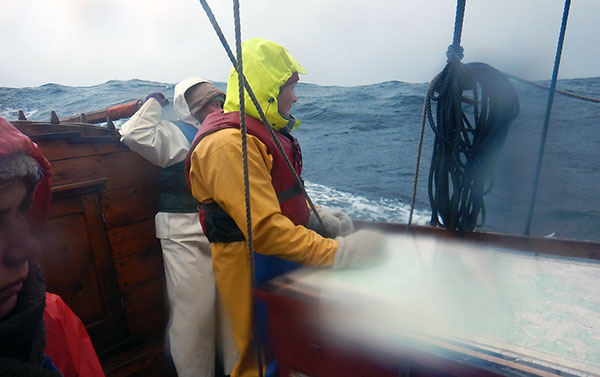
COURTESY OF FOSEN FOLKHØGSKOLE
Skipper Gunvor Storaas and First Mate Gea Prytz observe a particularly large wave while crossing the Westfjørd. Even in these near-gale conditions, it was comfortable and safe to stand in the boat’s stern.
With that 40 knots of wind on our stern, we sailed north the following morning. In the middle of the passage, with the promised winds blowing steadily, the waves were breaking turquoise, and we had reefed the sail to its smallest size. Before too much worry took hold in our minds, we saw the Lofoten Wall, the fortress-like mountain formation that heralds one’s arrival at the islands, rise up from the horizon. A crew member immediately pulled out her trumpet to celebrate our unspoken relief. We arrived in Stamsund, Lofoten, on May 4 to snowy, jagged peaks thrusting out of the steel gray ocean about nine hours after our departure.
Sailing a fembøring is like sailing in a giant leaf that flexes with each wave and swell. The hull is made up of seven strakes, each about ¾″ thick; the hull’s sides open up like the palms of two hands in a gesture of offering. “The waves are giving me a back massage,” reported one of the crew members lying with her back against the thin skin of spruce.
Running with the wind at 11 knots, the boat moved comfortably over the waves in long, loping strides, and the large, linen squaresail rocked back and forth like a big belly shaking slowly side to side. Closehauled, with the forward corner of the sail pinned temporarily to the windward side of the hull, the boat tracked ahead impressively at around 50 degrees off the wind.

COURTESY OF FOSEN FOLKHØGSKOLE
Julie Cordes celebrates the crew’s first sight of the Lofoten Islands with some improvised jazz on her trumpet after a rough nine-hour passage.
The crew rotated through all positions, from steering to navigating to handling the sheets, and we also rotated through tending to the well-being of the community—cooking meals, washing dishes, and even reading a romance novel aloud in Norwegian while the others rowed during moments of calm. Gunvor split the crew into two watches, one governed by her and the other by Gea. The watches changed every four hours, with the entire crew joining for a meal together at every change. For continuous passages of up to four days, the off-watch portion of the crew nestled together in the tiny aft cabin. Once the watch was over, and after a quick meal, the newly off-watch sailors quickly dressed down from at least ten layers of wool and foulweather gear and jumped into pre-warmed sleeping bags.
The sailors on duty rotated through each position on deck, spending about an hour at each station. The forward section of the boat is usually managed by one person who rigs and raises the topsail if it is desired; attaches the signat, a block-and-tackle used to tighten the luff; and overhauls, releases, or secures the bolina, a line attached to the middle of the leading edge of the sail. The bolina helps to control sail shape and aids in tacking and heaving-to.
Another person stands by to release the sheet from its pin when it is time to tack or jibe. Another crew member races the clew of the sail forward to a pin on the gunwale on the new windward side and secures the sheet around it as quickly as possible before the sail fills. Thus, the former clew becomes the new tack. The person managing the tack also usually handles the priar, a line attached to the middle of the foot of the sail, just forward of the mast, which adjusts the sail’s draft according to the point of sail.
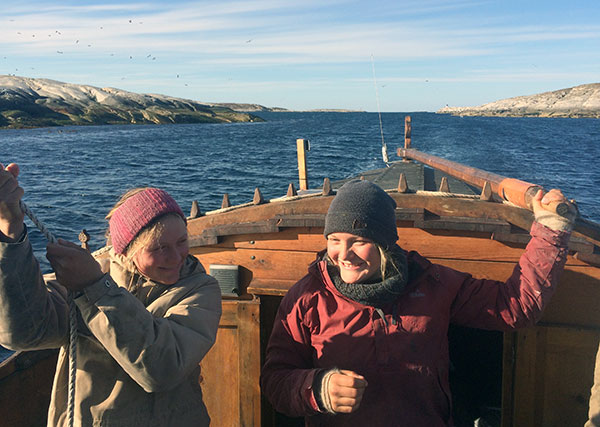
COURTESY OF FOSEN FOLKHØGSKOLE
While piloting through a particularly challenging area north of Vega Island, Gea Prytz handles the braces while Julie Cordes steers. Hundreds of rocky islands emerged at the water’s surface like the backs of whales. Note the rorgrind, or “tiller fence.”
Navigation involves keeping the chart updated under a thick piece of plexiglass on the chart table; plotting the course with parallel rulers and dividers; and taking a fix with the hand-bearing compass, or in a pinch, with the GPS.
In the stern, one person steers while another handles the sheets. The tiller is held above one’s shoulder, resting between little pegs on the aft cabin top. When steering the same course for a long period of time, this rorgrind, or “tiller fence,” gives a momentary respite, allowing the person at the helm to put on dry mittens, switch arms, or take a glance at the chart table without altering course. It also prevents any tendency to oversteer.
Gunvor or Gea, whoever was the on-duty watch captain at the time, stayed in the stern and handled the braces, two lines attached to either side of the yard, which control the side-to-side movement of the yard. Gea or Gunvor was also always within one foot of being able to drop the topsail or mainsail at any given moment. Halyards were secured with slippery hitches.
We handled the anchor only rarely, for we were often sailing in depths of 700' or more, even though we were usually just a few miles or less from land. If the winds and currents were strong and we were tacking for hours in the same spot, we didn’t have the option to drop the hook and wait it out.
The food kept well because the temperature in northern Norway in April and May is like living in a refrigerator. We cooked oatmeal for breakfast; had open-faced rye bread sandwiches with butter, cheese, canned fish, and pickled and fresh vegetables for lunch; and for dinner a hot meal of rice and beans, pasta, stewed vegetables, or (once) reindeer meat. Cod, caught and dried by the crew members in preparation for the expedition, was often pulled out for an afternoon snack, and on special occasions we had sourdough pancakes with chocolate or Norwegian brown cheese on top for dessert. Hot water boiled for coffee and tea frequently caused steam to pour out of the corners of the wooden cook box, reminding those sitting on top to check underneath and tend the stove. There was no head on board, so we went over the side or used a bucket in stormier conditions.
There seemed to be an unspoken awareness among the crew that the more one participated in the task at hand—washing the dishes, making the oatmeal, sheeting the sail, or pulling an oar—the more personal satisfaction was to be gained. The tasks became the joy. We tended constantly to the boat’s needs, the needs of the other crew members, and to our own well-being and safety. The boat provided the intensive space and inescapable container to build upon our capacity to care.
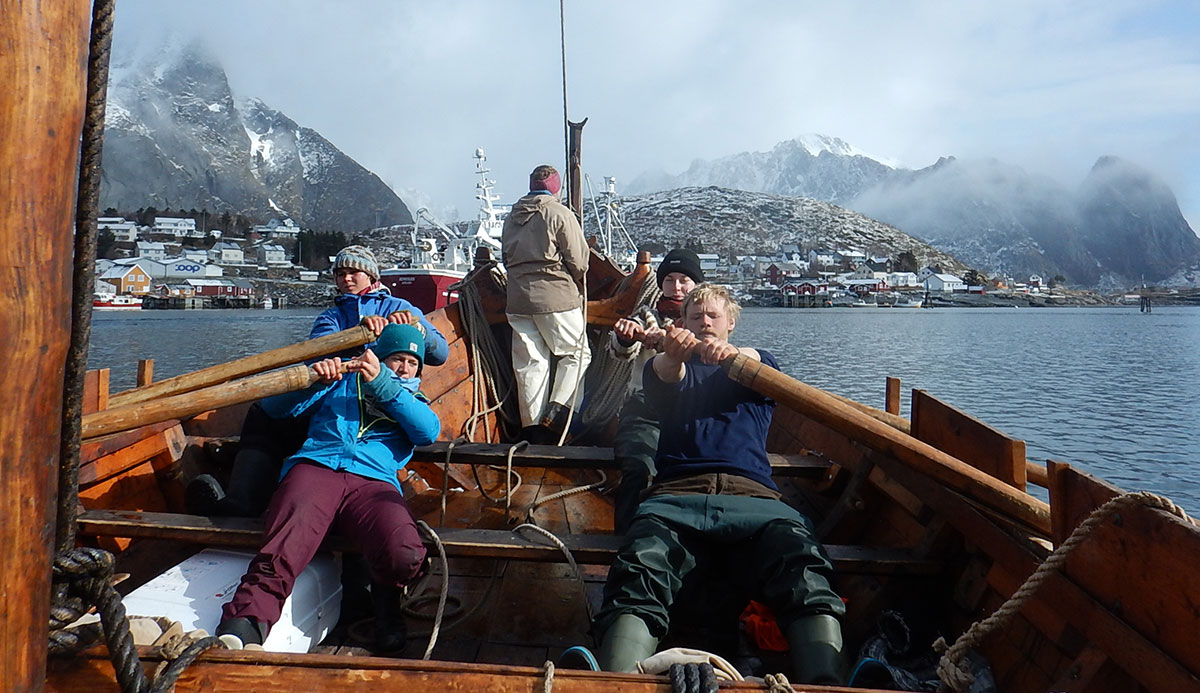
COURTESY OF FOSEN FOLKHØGSKOLE
Here the crew is rowing into Reine, a picturesque fishing village located in the western Lofotens.
When we left the Arctic on our return to Rissa, a week after our arrival in the Lofotens, the sun barely dipped below the horizon at night. An orange sunset bled into a bright pink sunrise that lasted most of the night.
A few days before arriving back in Rissa, while navigating through a tight cluster of barren rocks that broke the surface like the backs of whales, we missed seeing an aid to navigation and ran aground while running downwind at about 5 knots. We screeched to a halt. The sail was dropped. We bailed water from the bilge, lowered our small dinghy over the side, rowed about 30 yards, and lowered the anchor in about 40' of water to kedge off. We were under sail again in about 20 minutes. There was a short debrief reviewing how it happened, the skipper offered a warm, forgiving hug to the other in charge, and we all calmly moved on. We later discovered only minimal damage to the false keel.
We returned to Rissa, renewed and encouraged by our shared journey, and by being engaged in the needs of the boat and crew to create a safe journey for all. 
Arista Holden, captain and longtime seamanship instructor for programs such as Outward Bound, National Outdoor Leadership School, and Atlantic Challenge, will be occasional skipper of the new Massachusetts-based Viking ship replica POLARIS, which was built by F. Jay Smith and launched last November in Anacortes, Washington. She is also a member of WoodenBoat School’s waterfront staff and frequently rows and sails her 17′ Newfoundland skiff in waters near Brooklin, Maine.
The title of this article is based upon the English translation of the book Den Siste Viking (1921), by Johan Bojer, which describes the voyages of fishermen going to the Lofoten Islands and back in fembørings. Boher lived not far from the site of Fosen Folkehøgskole in Rissa, and his grandson, Jon Godal, established the sailing and boatbuilding programs at Fosen.
Of Færings and Fembørings
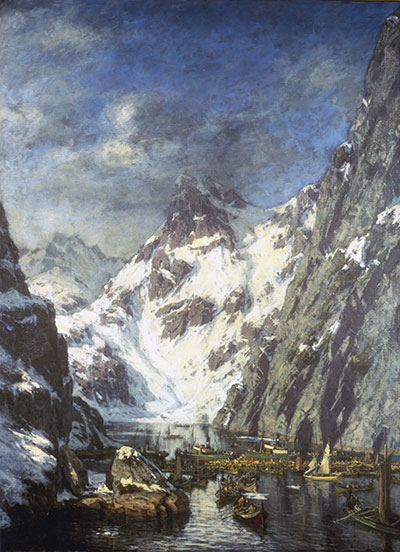
COURTESY OF SVINØYA RORBUER
The Battle of Trollfjord, painted by Gunnar Berg
For such a small country, Norway has a rich variety of traditional small boats—each one adapted to its particular region. And within those regions, there is further variety based upon the whims and styles of the builders.
Færings are among the best-known small boats in the country. They are propelled by two pairs of oars, which is what gives them their name: in the Old Norse language, it means “four oaring.” The færings of southern Norway tend to have curved, raked stems and are more heavily built than their plumb-stemmed, lighter cousins in the Nordland and Afjørd regions.
A fembøring has proportions and appearance similar to those of a færing, but it is larger, and driven by a squaresail in addition to oars. As mentioned by the main article’s author, Arista Holden, fembørings have distinctive cabins in the stern. These were built to be removable, and typically used for crossings from the mainland to the Lofoten cod grounds, and then carried ashore for land-based lodging, to make room aboard for fishing gear.
By 1890, the writing was on the wall for the open-boat Lofoten cod fishery. That year, a massive fleet of færings and fembørings encircled a fleet of industrial steam-driven vessels in an attempt to ban their access to the 2km-long (1.24 mile) Trollfjord. The incident is recorded in a painting by the Norwegian artist Gunnar Berg, who hailed from the Lofoten municipality of Svolvær.
You can experience a sampling of Norwegian small boats in the Boat Hall of the Norsk Sjøfartsmuseum in Oslo, which has, in addition to many other boats, a rigged fembøring on display. And the book Inshore Craft of Norway, edited by Arne-Emil Christensen from a manuscript by the Norwegian boat archaeologists Bernhard and Oystein Faerøyvik, is the standard introduction to the country’s small-boat types.
—Eds.
Building a New Fembøring
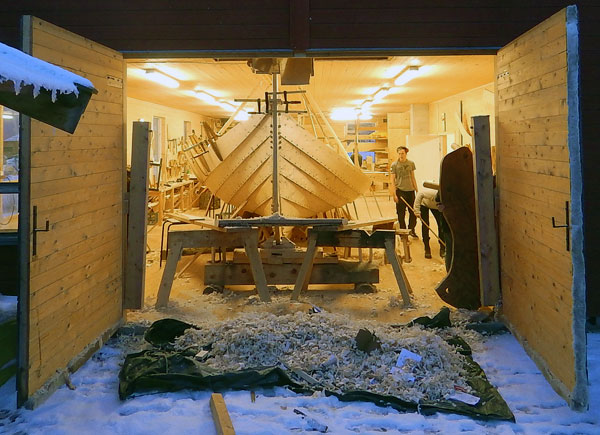
KENNETH BJØRKLI
Students in the boatbuilding program of Fosen Folkhøgskole built and launched a new fembøring, THORVALD HARALDSON, in 2017.
Days after our return to Rissa in mid-May, the newest Fosen-built fembøring was scheduled to be launched. Almost all of the 60 students at the school participated in the final push to get her ready in time, which involved painting the bottom and applying pine tar and linseed oil to the bare wood. On launching day, May 20, we lifted her onto two hand-drawn trolleys and hauled her 3km (1.9 miles) to the water’s edge. Three musicians played traditional tunes inside the boat as we paraded the new fembøring down the main street.
One of the 18 boatbuilding students, Arne Erikson, a 29-year-old Finnish-Norwegian, came to Fosen after studying marine biology and having spent “a little too much time putting numbers into spreadsheets.” He sought the sensory refreshment that building wooden boats could offer. His interest in his own family’s history of fishing and sailing from northern Norway inspired his decision.
In the fall, when the school year started, Kenneth Bjørkli, the boatbuilding instructor, brought the apprentice builders to a local forest to haul out the timber for the boat. He says, “It was a very good way to start the school year by learning how to manage big things, to learn how to lift together. We dragged out everything by hand. It was too wet to use a tractor.
“We need huge spruce trees for the planking stock for the big boats. They need to have tiny branches that hang down and a very circular trunk. When the branches hang down, that’s a sign that the wood inside will be soft and nice to work with.” He can’t use big lumberyards to get timber. It would be too expensive or difficult to obtain the appropriate dimensions in this way, so he has been forming his own relationships with the owners of the forest. For the newest fembøring, Kenneth selected and cut the timber during the winter a year before construction was scheduled to begin, giving the wood enough time to season.
The new fembøring was going to a private individual who would use the boat for rehabilitation work with ex-convicts. Kenneth recalls the challenges of teaching boatbuilding while also building a safe boat: “It’s not about building a boat, it’s about learning and how to become more self-confident, and how to work together. That’s what’s most important here. It is a balance to allow for people to develop, to make mistakes, and do things at a pace that suits them and in one year produce a seaworthy boat. That is the big challenge.”
Kenneth taught the students in the traditional way, with no lines drawings but a combination of using their eyes to make a specific curve and also a system of proportions, such as dividing the keel into specific fractions in order to decide where to put the frames and mast.
He has now built three fembørings over 40' and a handful of smaller færings at Fosen, where he studied 15 years ago. After sailing the first two fembørings, SKÅRUNGEN and FRI, he made small adjustments to improve the sailing capabilities of the newest boat. “We build using our eyes and our experience. The SKÅRUNGEN and FRI are too flat-bottomed, which probably makes them a bit slow when turning around. So we raised the sides a little on this new one, and it behaved quite nicely during the sea trials. It came about like a dream.”
Apprentice Arne Erikson spoke about a revelation he had while building the fembøring. “Once you stop thinking about it and go about things intuitively, you start to get it right. The human eye is really good at seeing irregularities in a line or curve. I don’t think it’s something some people can do or some people can’t do; I think it’s something that some people don’t get around to doing because they never let go of the idea that there is one certain, very scientific, methodical way of doing it. I thought it would be a rigid system of building boats, but it isn’t at all.”
On May 20, 2017, the THORVALD HARALDSON, named after its owner, was launched. About 30 Fosen students steadied the 2,500-kilo (about 5,500-lb) boat as she slid into the water, with Kenneth Bjørkli leading them through a traditional launching song. “It’s a local tradition,” Bjørkli said. “Everyone does it when they put their boat into the sea. The song helps us apply force at the right time. In the older days here in Rissa, there were special boat singers who were always called upon when a big boat was being launched. And then usually an old man came and sung the boat out.”
Following the launching ceremonies, Bjørkli said, “It’s not just saving the remains of the old tradition, really; it is about taking them and using them for what they are worth today. This means taking the students on sailing trips, learning about the sea, culture, and where they came from. In the 1800s, thousands of boats were built each year, and 10,000 boats were used each year. That is what you did—you built, you fished, you sailed. Nothing we do today can compare to that. Those times will probably never come back, but we can certainly learn a lot from that tradition—about ourselves, and physical work, and wood technology. The old culture represents extremely highly developed wooden technology, and it would be very sad if it completely disappeared.”
—AH
Visiting the Lofoten Islands
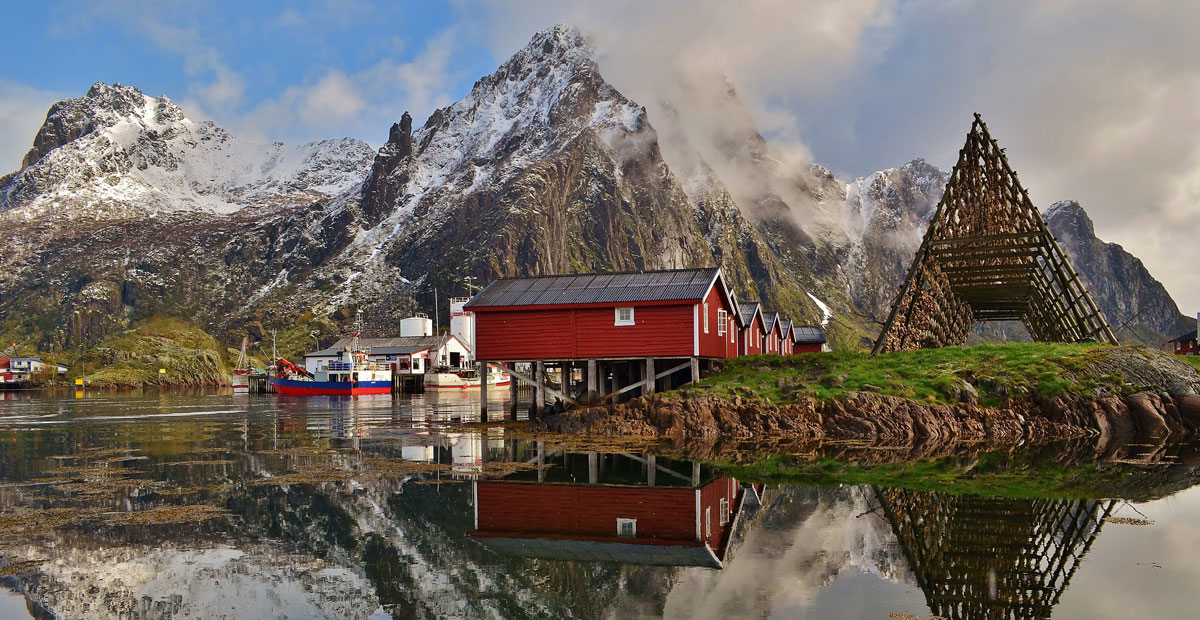
COURTESY OF SVINØYA RORBUER
Svinøya Rorbuer, in Svolvær, offers a number of converted fishermen’s cabins for rent.
To experience the Lofoten Islands without joining an expedition, a visitor can stay in a rorbu—a traditional fisherman’s cottage. Several companies in the region have converted these snug shacks (rorbuer is the plural form of the word) into tidy guest accommodations. One of our favorites is Svinøya Rorbuer (www.svinoya.no/en), which is located in Svolvær, the region’s administrative center. Svolvær, on the island of Austvågøya, is a good jumping-off point from which to visit the Lofotr Viking Museum in Borg, one hour away, whose centerpieces include a reconstructed Viking longhouse and a working replica of the Gokstad ship, a 9th-century vessel excavated from a burial mound in the 1880s and one of the ships on exhibit in Oslo’s Viking Ship Museum. A little further down the road is a coastal folk museum in the town of Å (that’s right, Å), a reconstructed village that interprets the Lofoten cod-fishing history. There are numerous other regional museums in the area, incomparable scenery, and magnificent hiking. It’s a wooden boat lover’s dream.
You can fly to the Lofotens on Norway’s domestic airline, Widerøe, but if you did you’d be missing a wonderful and scenic sea voyage from the mainland. For day ferries, see https://lofoten.info/Visitlofoten; for a cruise in Norway coastal steamer HURTIGRUTEN, see www.hurtigruten.us.
—Eds.

